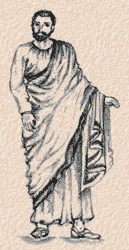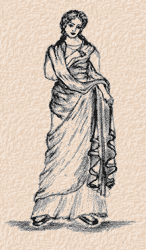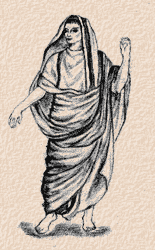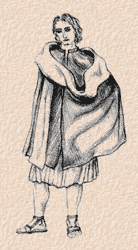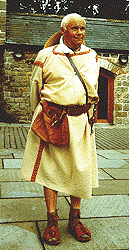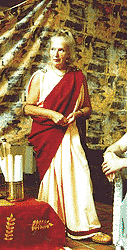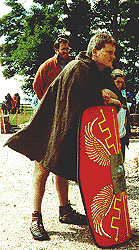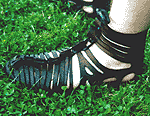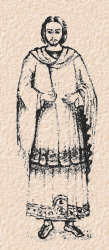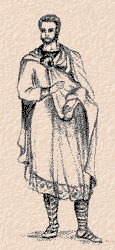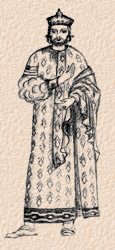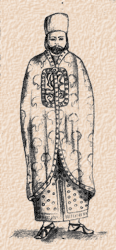|
Roman Empire
Home Page |
Roman Empire Children's Section |
| Roman Dress Dress of Rome |
|
|
|
|
|
Roman ingenuity of solving problems of all sorts was not only to apply itself to engineering and architecture, but also to the mundane matter of clothing.
First and foremost clothes needed to be simple. As for possible materials there was only really one. Wool, although to some extent linen was also available.
The needles of the day were coarse and unwieldy. Hence any stitching or sewing produced less than elegant garments. This of course also ruled out button holes, and meant that any kind of clothing was held together wither with knows or safety pins.
As undergarments Romans would wear a simply loin cloth knotted on each side. This garment appeared to have several names. The most probable explanation for this is that they varied in shape.
They were the subligar, subligaculum, campestre, cinctus.
Women would also wear a simple brassière in the form of a band, tightly tied around her body.
If in the early days the toga was worn directly on the naked body, then later a simple tunic was added, tied at the waist with a belt.
There was some old families with ancient ancestry insisted on continuing the tradition of dressing without a tunic, but their fellow Romans understood them to be old fashioned relics of times by.
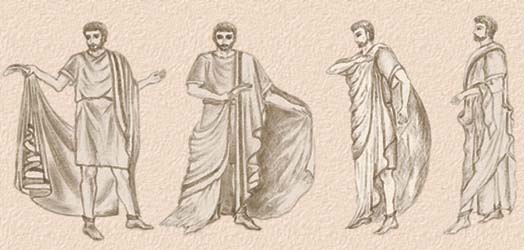
How to dress in a toga
The standard dress worn by Roman citizens was the toga for men and the stola for women.
Basically it was a large blanket, draped over the body, leaving one arm free.
Through experiments historians have concluded that the vast blanket took the form of a semi circle. It was along the straight edge the the purple stripe of a senator's toga praetexta ran.
It was up to 5 1/2 metres long and at its widest point it will have been up to 2 metres wide.
No doubt keeping such a cumbersome item of clothing on one's body, and looking elegant, will have been fraught with practical problems as one moved about, sat down and got up again.
It is also know that many politicians campaigning for public office would go as far as whitening their toga with chalk.
At dinner parties and in private the toga was simply deemed to impractical and so on such occasions it was often replaced by the synthesis, a sort of dressing gown.
However, at any public engagement the dignified toga was virtually obligatory, for anyone who didn't want to
be seen as a slave or a workman in Rome had to be seen in a toga.
The only exception for this was the festival of the saturnalia when everyone, including the magistrates,
left their toga at home.
|
|
|
The stola was as much the national costume for women as the toga was for men.
In early Rome women at first had worn the toga, dressing in the same fashion as the men. But very soon female clothing had begun to differ.
The stola was, much like the toga a large blanket, except that it was rectangular in shape.Draped around the body, it formed a long garment, reaching to the ground. A purple stripe (institia) lined the edge of the garment.
In the third century AD this toga matronalis was, like the male toga, replaced by the dalmatica.
As an overgarment women in the early days of the republic wore the ricinium, a simple square cloak, covering the shoulders. But later the ricinium was replaced by the palla.
|
Cloaks and other overgarments helped protect the Roman against bad weather. A variety are known, at times worn over the toga itself, but more often replacing it. The palla (or pallium) which was worn over the tunic or the toga. The lacerna was originally a military cloak, but during the empire it begun to be extensively worn by the middle class. The wealthier people tended to wear brightly coloured lacerna, whereas the poor wore cheaper dull, dark ones. The paenula was a very simple type of cloak, used especially as protection against bad weather. It was put on by simply pulling one's head through the central hole and was normally fitted with a hood. They could be made of either leather (paenula scortae), or very heavy felt (paenula gausapina). The laena (also called duplex) was thick, round cloak which was folded double at the shoulders and was generally of heavy material, much like the military cloak, the sagum. The poor wore short and dark laena, whereas the wealthy would wear brightly coloured one to cover their shoulders at banquets during the cold season. The cucullus (meaning 'hood'), as well as the bardocullus, birrus, and the caracalla, was a heavy hooded cloak. The caracalla (caracalla talaris) in particular reached to feet. It is especially famous as it lent its name to the emperor who still today is known under his nickname 'Caracalla' for habitually wearing the garment. However, this heavy cloak should not be confused with the female caracalla, which was a light, sleeveless linen wrap. |
Roman footwear showed little distinction between male and female. One usually wore sandals tied round the ankle with thin strips of leather.
There were three main types of footwear:
The calcei were the standard outdoor footwear for a Roman and formed part of the national dress with the toga.
It was a soft leather shoe, generally speaking a cross between a shoe and a sandal.
Sandals (soleae or sandalia) were generally regarded as indoor footwear. It was as much an outrage to be seen in public wearing sandals outside as it was to visit your host's banquet in anything other. Hence a wealthy Roman would have a slave accompany to a banquet, to carry his sandals, where he would change into them.
The third general type were simply slippers (socci), which were also meant for indoor use.
| There were of course other types of footwear. The pero was a simple piece of leather wrapped around the foot, the caliga was the military sandal and the sculponea was a wooden clog, worn only by poor peasants and slaves. |
|
The tradition of intricately groomed beards was quite common among the Greeks and Etruscans (the principle cultural influences on the Romans). The Romans though until 300 BC remained pretty much ungroomed.
It was only with the introduction of the fashion of shaving during the age of Alexander that the Greeks began to shave. This of course also happened in the so-called area of Magna Graecia in southern Italy which was controlled by Greek colonies. From there the fashion was introduced to the Romans. It finally took a firm hold in Rome in about the third century BC. The great general Scipio Africanus is believed to have been the first to have begun the fashion of shaving daily. During the third century BC many barbers from the Greek parts of Sicily moved to Rome and opened shops.
Young men tended not to shave at first and it was seen as very fashionable to keep a small, well-groomed beard (barbula). It was largely when the first grey hairs started showing that the beard would be shaven off completely.
This fashion lasted for a long time until the reign of emperor Hadrian. Hadrian's face was slightly disfigured, hence he grew a beard to hide the fact. Beard hence returned to fashion, until the the reign of Constantine the Great who reversed the trend, with the men of the empire remaining mostly clean-shaven.
As for Roman men's hairstyles, they tended all to keep their hair cut short. Some very vain ones might have had their hair curled with curling irons, whilst being pampered for hours at the barbers'', but they were a small minority. Under Marcus Aurelius the fashion for shaving one's head clean was introduced. Whilst early Christians tended to have their hair and beards cut short.
Women, in Rome, just as in any other civilization to this day, wore far more elaborate hairstyles than their men.
Young women simply gathered their hair into a bun at the back of the neck, or coiled it into a knot a the top of the head.
Married women's hairstyles were more complicated. At first, the women of early Rome wore their hair in Etruscan fashion, keeping all of it tied up tightly with ribbons on the very crown of the head (tutulus). Though this strange arrangement disappeared very soon, though some priestesses still retained its use.
The age of the Flavian emperors (Vespasian, Titus and Domitian) is largely seen as the age of the most flamboyant fashion in hairstyles.
On of the styles used largely at court had the hair arranged in several layers, falling to the face in an abundance of ringlets.
Such fashion in hairstyle required expert hairdressers, as well as false hair to be added to create such a mass of hair.
False hair, wigs, hair lotions and dyes were all known to the Romans.
Much like today, many women had their hair bleached blonde. And to supply the demand in blonde false hair, needed to complete the complicated hair styles, a flourishing trade in blonde hair from blonde northern barbarians sprung up.
| Byzantine Dress Dress of Constantinople |
|
|
|
|
|
|
|
Roman Empire
Home Page |
Roman Empire Children's Section |
